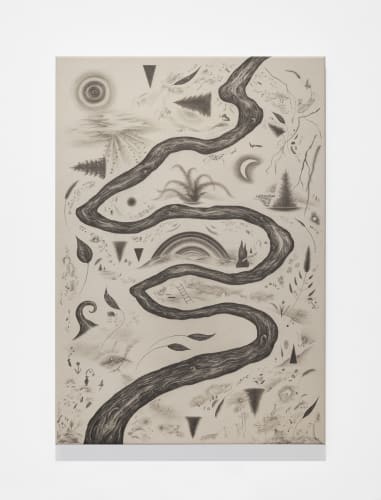Inman Gallery is pleased to present Robyn O'Neil: HELL and the Paradisal on view in both gallery spaces September 17 – November 5, 2022. A conversation between Robyn and musician Damien Jurado will take place from 1-2pm on Saturday, September 17 as part of our all-day open house, with the artist present until 4pm.
In HELL and the Paradisal, O’Neil presents a body of new work which are reactions and responses to her epic 2011 drawing HELL (2011), which is installed in the south gallery. In the main gallery, a group of graphite on canvas works collectively titled The Paradise Fields, are accompanied by other recent graphite drawings on canvas and paper. Directly informed and inspired by the HELL triptych, the Paradisal works are a reflective exercise for O’Neil as she looks back on this monumental piece in the context of her present-day practice. There are several formal commonalities between HELL and the new works in the Paradisal: ferns growing from above, abstracted floating tree branches, dramatic cloud formations, shapes, and ghostlike enigmatic imagery. The tone, however, is entirely different. HELL is about death and destruction, while the Paradisal pieces are about growth, connection, beauty, thriving, nature, and calm, the latter the antidote to the former.
In contrast to HELL, the Paradisal realm of the exhibition is distinctively earthly, centering nature, flora, and fauna as primary subject matter over human figures, with minimal, impressionistic landscapes interspersed between hyper-detailed compositions. Significantly smaller in scale, these new works are intimate and welcoming, a stark contrast to the grandeur and might of HELL. In addition to the three Paradisal Fields works, there are a number of works on paper with animal imagery and three, small-scale nocturne landscapes. Rendered in greyscale, O’Neil’s nocturne drawings mimic the artist's early exposure to art history: as black and white reproductions in books and magazines at the library. Many works exist in sets of three because, as O’Neil points out, the Roman Catholic Church’s matins prayers are said at night and organized into three lessons. As with HELL, several art historical references are scattered throughout the exhibition, with homages to James Abbott McNeil Whistler’s Nocturne paintings, Albert Pinkham Ryder’s landscapes, and nineteenth-century botanical illustrations of Ernst Haeckel and Orra White Hitchcock, among others.
O’Neil’s monumental, complex HELL triptych contains 35,000 collage elements and over 65,000 figures (both drawn and collaged). Working 18-hour days nearly every day over the course of its making, the piece took three years to complete. HELL continues O’Neil’s devotion to revisiting her art historical influences, recalling traditions of religious altarpiece painting, among other references. Hieronymus Bosch’s influence is most apparent in both concept and format, with the 16th century Dutch master’s Garden of Earthly Delights informing O’Neil’s own underworldly, infernal landscape. It is as if O’Neil has taken Bosch’s own colorful (and quirky) triptych of Earth, Heaven and Hell, stripped away any references to the former two, and produced a three-panel monochromatic hellscape for her signature men in sweatsuits. Over the course of her career, O’Neil has charted the tragicomic absurdity of mankind’s negligent and blatant disregard for nature and the environment by way of the mishaps and activities of these men in sweatsuits. In 2011, through this work, the men were banished to this hellish realm for their crimes. “Abandon all hope ye who enter here,” to quote the phrase from Dante which is said to be inscribed over the gates of Hell.
The HELL triptych and the shift towards the Paradisal is also personally significant for O’Neil; while HELL represents a harsher past (when she was creating work that referenced a darker, more sinister era), the Paradisal works envision a softer and more hopeful future. This is methodically captured through O’Neil’s shift towards drawings on canvas and warm-toned paper in her more recent works. Even though HELL remains resonant to the human condition a decade after its making, O’Neil herself is situated in a more content landscape. Likewise, compared to her older body of work, O’Neil’s current practice has evolved to where she is drawing less harshly than before, as she points out:
“If you look back at over 20 years of my drawings, I always drew with a heavy hand and used very dark graphite. In these new drawings, I’m finally learning to draw softly and with an ease. The harshness in the past was for a reason - I was creating an anxious, apocalyptic world in which nothing connected harmoniously. The gentle way in which I’ve drawn most of the new pieces mimics the overall purpose of these - this world isn’t nearly as bleak and unmelodious.”
The exhibition HELL and the Paradisal is a dialectical interplay between past and present, angst and calm, dread and longing in O’Neil’s oeuvre. Her new works are indicative of an artist who has grown and evolved. Coming out of her mid-career retrospective at the Museum of Modern Art, Fort Worth in 2020, O’Neil’s Paradisal works show how the fury of the HELL piece has been transformed into something softer, smaller, more nurturing and peaceful. HELL is indeed a true masterpiece, and yet the Paradisal showcase the works of a matured, well-balanced artist who has come of age in times of great challenge and adversity. Nestled within the drawing You and I Are Earth (2022), O’Neil includes a quote by Irish novelist Samuel Beckett which states “ ... you must go on. I can’t go on. I’ll go on.” It is a drive to persevere which Beckett speaks to and O’Neil references—the drive to succeed in the face of failure— that poignantly sums up the human condition around which her entire body of work revolves, and which perfectly summarizes Robyn O’Neil’s prodigious and celebrated career as a visual artist.

